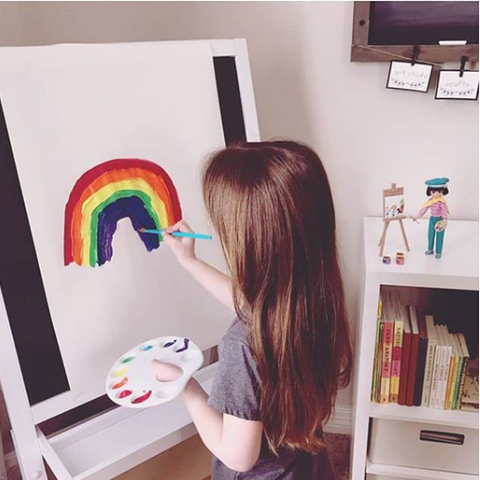Practicing mindfulness with your kids can help them regulate emotions, teach them coping techniques for stress, and promote overall well-being. But “mindfulness” doesn’t have to be complicated or difficult to be effective. If you’re looking to add some relaxation and mindfulness techniques into your daily routine with your kids, here are 15 ways to approach mindfulness for children – but it’s handy for adults, too!
What is “mindfulness,” anyway?
You don’t have to go on a week-long silent retreat to reap the benefits of mindfulness. Simply put, mindfulness is “the basic human ability to be fully present, aware of where we are and what we’re doing, and not overly reactive or overwhelmed by what’s going on around us.”
Children are learning to navigate their big emotions, and they turn to us for help. Practicing mindfulness can make the whole family more focused on self-reflection and help us navigate the stressful situations that pop up in everyday life.
Focus on the senses
When your child is overcome with big emotions and feels overwhelmed or out of control, have them focus on their senses. Ask them to identify something they can hear, see, touch, or smell. Focusing on one particular scent or sound can help reduce feelings of stress or anxiety. Our senses ground us in the present moment, and keep us focused on the here and now instead of the “what ifs”.
Encourage deep breathing
Taking a few deep breaths can help get some oxygen to our brains, as well as distract us from whatever is causing us stress. If your child is frustrated or angry, have them take a few deep breaths before talking it out. Sometimes, that’s all they’ll need to calm down!
Press Pause
Mindfulness is just the observation of our thoughts and feelings. If you notice your child becoming wound up about something, have them “press pause” and identify what they’re feeling. Are they feeling angry, or are they frustrated? Are they upset about a fight with a friend, or are they worried about a big upcoming change? It can be helpful to try to identify big feelings (and talk about what’s causing them) before they become overwhelming.
Help remove judgement
It is healthy and normal for children to have big feelings, especially in times of stress or anxiety. Sometimes, kids can be upset that they can’t control these feelings – which can make the situation even worse. Encourage your child to talk about their feelings, assure them that you’re a safe space, and help them express big feelings in a healthy way.
Designate specific “mindfulness” time into your routine
It’s important to practice mindfulness techniques when you’re calm and relaxed. That way, you can easily rely on them when you need them the most. Try implementing a mindfulness habit into your child’s daily life.
Add some meditation to the bedtime routine, take a mindful walk after breakfast, throw in some yoga after lunch. Adding mindfulness practices to your everyday life can turn them into helpful tools when things get chaotic.
Practice observing thoughts and emotions
Think of it like this – our thoughts are like trains, rushing into a busy station. Instead of hopping onto each train of thought and riding it into a frenzy, have your child imagine themselves sitting on a bench in the station. Watch the thought, consider the thought, but don’t react. Just observe it as it pulls away, and the next one pulls into the station.
Remove electronics
No, you don’t have to take away the screens forever. There are plenty of mindfulness apps that can help guide your kids through meditation exercises or breathing techniques. However, while electronics are fun and handy, they can distract us from important feelings and prevent us from tuning into our bodies and minds.
Try limiting electronics and let your kids be bored for a change. See what they can come up with when they only have their imaginations to guide them.
Go outside
Something as simple as spending time in nature can put us more in tune with our bodies and minds. Take a walk, play a game, lay in the grass and watch the clouds. Spend time reconnecting with nature to reconnect with yourself, too.

Try a “body scan”
Focusing on how your body feels can help focus your mind, too. Have your child perform a “body scan” – ask them to lie down, close their eyes, and check-in with each part of their body (starting with the top of their heads all the way down to the soles of their feet). Ask them how each body part is feeling, and see if they can relax it one at a time.
Make art together
Have your child put their thoughts and feelings onto paper. Ask them to explain their drawing to you, so you can talk about what it means.

Moving your body is a great way to practice mindfulness, and introduce it to kids. Going for a walk, practicing some yoga, or even having an impromptu dance party can help connect your body and your mind – especially if your mind needs a bit of winding down.
Journal it
For older children, writing their thoughts and feelings in a private diary can help them release tension and provide some structure. Journaling can also help improve writing skills, too!
Try a puzzle
Choose an activity to do together that requires concentration. This is one of my favorite ways to practice mindfulness because it forces me to focus only on the task at hand, and leave my rogue thoughts for another time.
Read a book – together
Sometimes, it can be really helpful to just get lost in a book. Books can be helpful tools for grounding us within our own minds, and providing a healthy distraction from an overwhelming world. If your child is too young to read (and even if they’re old enough), read together! Talk about the characters and their feelings – and see what your children have to say.
Have regular conversations about feelings
This may seem like a basic tip, but practicing conversations about small feelings can give you practice for the big ones. Regularly ask your child how they’re feeling, and ask what you can do to help. As parents, we don’t always know how to say the right thing – and that’s okay. At the very least, your child will know they can come to you with big thoughts and feelings, and that’s all that really matters.
Whatever technique you choose to approach mindfulness with children, practicing mindfulness can help your child slow down, organize their thoughts, and set up a healthy emotional framework for the future. But remember, the best way to approach mindfulness with your children is to practice mindfulness yourself!
![]() Fast Shipping
Fast Shipping![]() Subscribe to our Newsletter
Subscribe to our Newsletter![]() 🌟 New Global Competition 🌟
🌟 New Global Competition 🌟













